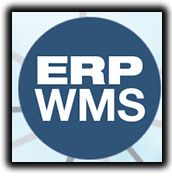The Path Forward for ERP WMS
There’s nothing static about warehouse management systems from enterprise resource planning suppliers. The user base is expanding at a notable clip, and next-generation supply chain technologies from the Cloud to data analytics and smart glasses are in their future.
Talk with enterprise resource planning (ERP) suppliers about their warehouse management systems (WMS) long enough, and it feels like a proxy about the future of next-generation supply chain technologies. Artificial intelligence (AI), wearables, voice, data analytics, Internet of Things (IoT), and, of course, the Cloud all figure prominently in the discussions.
Many in the supply chain look at several of those technologies as barely here in 2018. But clearly, so much development emphasis on next-generation technologies in ERP WMS does bring a new vibe to the discussion.
“We now know that these advanced technologies are no longer futuristic concepts—they are a reality,” says Diego Pantoja-Navajas, vice president of WMS development for Fusion SCM development at Oracle.
It’s imperative to note that all of this is in the early stages of building even more highly integrated, connected ERP WMS systems. But there does seem to be a sense that what has long been called “good enough” WMS is moving in a direction that brings even more value to distribution operations.
However, the question remains: Is ERP WMS at an inflection point for shedding the “good enough” moniker for its software? The answer to that is somewhere in the future, but there’s no question ERP WMS is in as strong a position as it has ever been.

Where ERP WMS sits today
Dwight Klappich, vice president of supply chain execution research at Gartner, says a recent study of his indicates ERP WMS is growing faster than best-of-breed WMS in terms of new clients. This is the first time in the 11 years of Gartner’s supply chain technology user study that has been the case, he adds.
Beyond new clients, mega-suite suppliers (Klappich’s name for ERP WMS suppliers) are strongly favored among users. Klappich says 62% of study respondents are strongly committed to a single mega-suite provider such as Infor, Microsoft, Oracle or SAP. And, 47% of respondents say they have a strong preference for their mega-suite provider’s WMS and will only look elsewhere if the offering is notably substandard.
He goes on to say that among the half dozen most prominent supply chain modules in the mega-suites, WMS is “extensively utilized” by 38%. Only the order management module is more favored at 40%.
What’s the state of ERP WMS today? “It’s healthy, mature, a workhorse and tightly integrated with ERP and its business apps that impact the warehouse and vice versa,” according to Justin Ward, senior product manager at Epicor.
That doesn’t mean ERP-provided WMS is in a dominating position. It isn’t.
Best-of-breed WMS is in a strong position, too, says Dan Gilmore chief marketing officer for Softeon. “The idea that ERP WMS is going to put best-of-breed out of business is not even part of the discussion today. There’s enough market for all suppliers of WMS,” he says.
Going forward, both WMS armies face a changing distribution world. To begin, several distribution segments are undergoing unprecedented change. Key areas are retail, especially omni-channel retailers, consumer goods companies and industrial distributors, says Gilmore.
On a broad scale, the types of DCs are changing, too. Companies continue to build large, automated DCs with high volumes requiring complex order fulfillment functionality—long the stronghold of best-of-breed systems. At the same time, there’s a move to putting DCs closer to customers, resulting in smaller DCs—the traditional sweet spot for ERP WMS.
But across the board, the battle going forward will be the same: How do warehouse management systems receive, fill and ship orders with the fewest constraints along the way?
This is the story of how ERP WMS is approaching that goal.

Value of the Cloud
Next-generation technologies clearly have great promise for ERP WMS packages. Regardless of the technology in play, the intent is to build even greater real-time inventory visibility than is possible today.
Suppliers consistently tout the integration of their WMS modules with other segments of the ERP system. Many call it embedded and point out that there’s no need to synchronize the two. But, the story doesn’t stop there.
Best-of-breed WMS is best known for its superior functionality. That is where ERP WMS wants to go and where next-generation technologies show their mettle.
Most of them start with the Cloud. While the Cloud is not new to ERP WMS, it’s taking on added importance. “To begin, hundreds of installations have made it clear that you can run WMS in the Cloud,” says Pantoja-Navajas. “Furthermore, real Cloud applications are laying the foundation for innovative solutions from IoT to blockchain.”
“Companies that want to go into the Cloud want to eliminate customization as well as the impact of integration without sacrificing functionality,” says Infor’s industry strategist Edward Talerico. “Information technology should be a commodity. That allows companies to focus on making and selling widgets. The Cloud allows them to do that,” he adds.
At this point, it is not unheard of to run ERP WMS in the Cloud. But it’s worth noting that many different forms of the Cloud are available.
For instance, IFS senior advisor Jakob Bjorklund speaks of his company’s software-as-a-service (SaaS) that runs the WMS completely in the Cloud, completely managed by IFS. There’s also IFS Managed Cloud that runs in either a highly secure, private installation that is fully maintained, updated and monitored by IFS.
Meanwhile, Oracle speaks of its SaaS as well as its platform-as-a-service (PaaS) and infrastructure-as-a-service (IaaS). The platform approach offers three different schemes for the user and Oracle to manage and control the ERP system with different degrees of Cloud privacy.

Data analytics move in
When it comes to next-generation technologies, the Cloud typically supplies the backbone to integrate the visibility supplied by them. Data analytics offer a new way to look at all that data so visibility results in the right actions at the right time.
Infor calls it connected intelligence. About a year ago, the company purchased Birst for its Cloud-native, business intelligence analytics and data visualization. As Talerico explains, it’s a matter of managing data through predictive analytics to improve the flow of product from manufacturing through to the customer. “If a company can anticipate demand through predictive analytics, it will require less inventory and can speed the movement of inventory through the supply chain,” he says.
Earlier this year, Epicor introduced Epicor Data Analytics (EDA) for Prophet 21 in the Cloud. While EDA has a broad portfolio, Epicor’s Ward says the package’s capabilities can get as granular as analyzing demand, inventory and warehouse location to streamline flow through the DC.
He continues to say, “there is a huge opportunity for data analytics in ERP WMS. It can improve workload, workflow, inventory levels and staffing. It can go so far as to manage picking tasks based on the work queue, track the time needed to pick items, and predict how long it will take to pick an order. It’s a matter of comprehensive integration of data to improve operations.”
Ward has other aspirations for data analytics, too. He expects that, in time, it can be used to reduce warehouse labor costs as much as 10% to 20% through improved productivity out on the floor.

On the warehouse floor
Fortunately, data analytics is just one of the technologies moving ERP WMS forward.
Voice, augmented reality smart glasses and autonomous mobile robots are part of the mix at the pick face, explains Richard Kirker, SAP’s global solutions owner for WMS.
At an SAP warehouse in Germany, autonomous mobile robots from Fetch Robotics pick multiple orders in multiple picking areas.
“The robots are smarter than traditional AGVs, which operate much like a fixed conveyor,” says Kirker. As a result, he explains, the robots need fewer messages than conveyors from the WMS to pick items and orders across the warehouse floor. In other words, the ERP WMS running in the Cloud leverages the robots’ autonomous capabilities to efficiently pick items and deliver orders to shipping.
A completely different approach to picking involves smart glasses, says Kirker. And, he’s quick to point out these are fairly high-tech picking glasses for hands-free data management.
At a high level, the WMS directs picking and communicates with the picker through voice commands and augmented reality on the smart glasses. A camera integrated with the glasses scans bar codes. That combination, says Kirker, delivers commands directly to the picker and confirms accuracy of picks long before the assembled order gets to shipping. Under SAP’s approach to Cloud-deployed WMS, the Cloud ensures rapid communication with the smart glasses.
Without the Cloud, the lag time to relay all that data and messaging from the WMS would slow the picker to unacceptable levels.

The long game
Clearly, ERP WMS is moving into new territory. All of what is discussed in this article ranges from available today to early pilot stages. But, there is a path.
“We’re pursuing real-time inventory visibility at all stages supported by a WMS that is part and parcel of ERP. The idea is to streamline where possible and deliver higher functionality,” says IFS’ Bjorklund.
Getting there requires a four-pronged approach, says Infor’s Talerico.
First, improve the user experience through better warehouse workflow. Second, increase functionality based on specific industry requirements. Third, maximize the impact of the Cloud’s capabilities. And, finally, build emerging technologies into the mix to add functionality to ERP WMS.
By all indications, this is more than aspirational. The path forward for ERP WMS is set for now.













